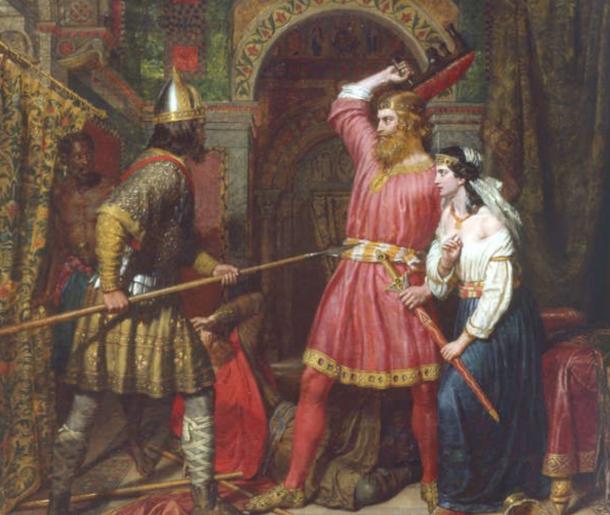🔴 Website 👉 https://u-s-news.com/
Telegram 👉 https://t.me/usnewscom_channel
The Lombards were a Germanic people who played a significant role in shaping the history of Europe, especially during the early medieval period. Originating from the lower Elbe River region, the Lombards migrated southward and eventually established a powerful kingdom in Italy. Their history is marked by periods of warfare, migration, and eventual settlement, culminating in the establishment of a realm that would endure until the late 8th century AD and beyond. But ruling this newly made kingdom was a task cut out only for the most capable rulers. So let us explore the lives and reigns of ten of the most important Lombard kings, highlighting their contributions to the legacy of the Lombard people and their influence on European history.
The Birth of a New Kingdom
The earliest origins of the Lombards are somewhat obscure and are still subject to much studying. Originally known as the Langobards, they were a Germanic tribe that likely originated in the lower Elbe River region, in what is now northern Germany. It is believed that they initially lived as a small and relatively obscure group before migrating southwards, possibly due to warfare with the neighboring tribes of Slavs and Germanics. According to their own lore, as recorded in the “Origo Gentis Langobardorum,” they were named “long-beards” by a divine decree. Over time, they moved through various regions of Central Europe, absorbing influences from other tribes and honing their skills as formidable warriors. This period of migration and cultural integration set the stage for their later establishment as a dominant force in Italy, under the leadership of Alboin.
1. Alboin (r. 560-572 AD)
Alboin is perhaps the most famous of all Lombard kings, credited with leading his people into Italy. Before his Italian campaign, Alboin defeated the Gepids, a rival Germanic tribe, and took their king’s daughter, Rosamund, as his wife. In 568 AD, Alboin led the Lombards, along with several other tribes, across the Julian Alps into the rich and fertile lands of northern Italy. This migration marked the beginning of a new era for the Lombards, and the Italian Peninsula on the whole. Alboin’s conquest of Italy was swift, and by 572, he had established his capital in Pavia. However, his reign was cut short when he was assassinated, reportedly at the behest of his wife, Rosamund, in revenge for his harsh treatment of her. His death, however, was the result of a coup d’état instigated by the Byzantines.
Alboin is killed by Peredeo while Rosamund steals his sword, in a 19th-century painting by Charles Landseer (Public Domain)
2. Authari (r. 584-590 AD)
Authari was the son of Cleph, another significant Lombard king who succeeded Alboin but only reigned for 18 months before being assassinated. Then, after a decade of political instability and interregnum following the death of King Cleph, Authari ascended to the throne. His reign is noted for consolidating Lombard power in Italy and strengthening the kingdom’s administrative structure. He sought to solidify Lombard control over the various duchies and curbed the independence of local dukes, thereby reinforcing central authority. Authari also engaged in diplomatic efforts, notably marrying Theodelinda, a Bavarian princess, to forge an alliance with the Bavarians. His reign was relatively short, but his efforts laid the groundwork for a more unified Lombard kingdom. He is considered the first Lombard king who began adopting Roman customs and practices and beginning to tolerate Christianity.
3. Agilulf (r. 591-616 AD)
Agilulf, the Duke of Turin, succeeded Authari and continued his policies of consolidation and centralization. Agilulf’s reign saw the continuation of efforts to strengthen the Lombard state and expand its territories. He managed to repel the Frankish invasions and secured the Lombard kingdom’s borders. Agilulf was also a proponent of Roman culture and worked towards integrating the Lombards into the existing Roman societal structures. His marriage to Theodelinda, who was a devout Catholic, led to significant religious changes within the kingdom. Although Agilulf remained an Arian Christian, Theodelinda’s influence promoted Catholicism among the Lombards, leading to increased religious unity and closer ties with the Papacy.
Theodelinda, queen of the Lombards, marries Agilulf, duke of Turin, in a painting by Fratelli Zavattari. (Public Domain)
4. Rothari (r. 636-652 AD)
Rothari is remembered for his significant contributions to Lombard law. Before becoming king, Rothari was the Duke of Brescia. As king, he enacted the “Edict of Rothari,” a codification of Lombard law that provided a written legal framework for his kingdom. This legal code, written in Latin, was a crucial step in the transformation of the Lombards from a warrior society to a more structured and legally grounded kingdom. Rothari’s edict covered various aspects of law, including property rights, inheritance, and penalties for crimes, thereby providing a degree of legal consistency and stability. His reign also saw military successes, particularly in consolidating Lombard control over northern and central Italy. However, he also had a darker legacy, having been responsible for putting many insubordinate Lombard nobles to death.
Codex legum Longobardorum (laws of the Lombards), Italy 11th Century. Cava Dei Tirreni, Archivio Della Badia Della Ss. (11th century. Library of the Benedictine Abbey, Cava dei Tirreni, Salerno/CC BY-SA 4.0)
5. Grimoald (r. 662-671 AD)
Grimoald was a strong and effective leader who came to power through a coup. He was initially the Duke of Benevento, a region in southern Italy. Grimoald’s reign is noted for his military prowess and strategic acumen. He successfully defended the Lombard kingdom against external threats, including the Byzantines and the Franks. Grimoald also continued the work of previous kings in consolidating the kingdom and ensuring the loyalty of the various Lombard dukes. His marriage to a daughter of King Aripert I helped solidify his claim to the throne and stabilize his rule. Grimoald’s reign was marked by relative peace and prosperity, allowing for further development of Lombard society and culture.
6. Perctarit (r. 661-662; 672-688 AD)
Perctarit initially ruled as a co-king with his brother Godepert but fled into exile after Grimoald’s coup. Following Grimoald’s death, Perctarit returned to reclaim his throne. His reign is characterized by efforts to restore stability and continuity after a period of upheaval. Perctarit was a devout Catholic and worked to strengthen ties with the Papacy. Thus, he is remembered as the first Catholic Lombard King. His policies promoted religious unity within the kingdom and helped to mitigate the divisions caused by previous conflicts. Perctarit’s reign also saw the continuation of efforts to integrate the Lombard and Roman populations, fostering a more cohesive society. His relatively long reign allowed for sustained peace and development in the Lombard kingdom.
7. Cunipert (r. 688-700 AD)
Cunipert was the son of Perctarit and continued his father’s policies of promoting religious unity and strengthening the kingdom’s ties with the Papacy. His reign is noted for his efforts to resolve internal conflicts, particularly those arising from the schism between Arian and Catholic Christians within the kingdom. Cunipert’s diplomatic skills were instrumental in maintaining the kingdom’s stability and fostering a sense of unity among his subjects. His reign saw relative peace and stability, allowing for continued economic and cultural development. Cunipert’s efforts to promote religious harmony were significant in shaping the future direction of the Lombard kingdom.
8. Liutprand (r. 712-744 AD)
Liutprand is often regarded as one of the greatest Lombard kings. His long reign was marked by significant military and political achievements. Liutprand expanded Lombard territories, notably conquering parts of the Exarchate of Ravenna, and successfully defending his kingdom against external threats. He also strengthened the central authority of the monarchy, curbing the power of the local dukes. Liutprand’s reign is notable for his efforts to codify and reform Lombard law, building on the work of Rothari. He also played a crucial role in promoting Christianity within his kingdom, supporting the Catholic Church and its institutions. Liutprand’s reign marked the absolute zenith of Lombard power in Italy, and his policies left a lasting legacy on the kingdom.
The so-called “Pilatus’ basin,” standing in the middle of the so-called “Pilatus’ Courtyard,” is a Lombard sculpture dating from the 8th century. It bears the names of the Lombard kings Liutprand and Ilprand. (M.Violante / CC BY-SA 3.0)
9. Ratchis (r. 744-749; 756-757 AD)
Ratchis initially became king following Liutprand’s death but abdicated to become a monk. His reign was marked by a continuation of Liutprand’s policies, including efforts to maintain the kingdom’s stability and promote religious unity. Ratchis’ decision to enter a monastery was unusual for a king, reflecting the increasing influence of Christianity and monastic ideals within the Lombard kingdom. He was briefly restored to the throne after the death of his successor, Aistulf, but his second reign was short-lived. Ratchis’ reign is indicative of the complex interplay between political and religious forces in the Lombard kingdom during this period. He was a noted warrior-king, fighting himself in his campaigns against the Slavs of Carniola.
Altar of Ratchis in Cividale, Italy in memory of his father Pemmo. (Welleschik/CC BY-SA 3.0)
10. Desiderius (r. 756-774 AD)
Desiderius was the last Lombard king, and his reign marked the end of Lombard rule in Italy. Initially the Duke of Tuscany, Desiderius came to power after the death of Aistulf. His reign saw significant efforts to maintain the kingdom’s independence in the face of increasing pressure from the Frankish kingdom under Charlemagne. Desiderius attempted to strengthen his position through alliances, notably marrying his daughter to Charlemagne. However, tensions between the Lombards and the Franks escalated, leading to Charlemagne’s invasion of Italy. In 774, Charlemagne captured Pavia and deposed Desiderius, ending Lombard rule and incorporating the Lombard kingdom into the Carolingian Empire. Despite his ultimate failure, Desiderius’ reign represents the final chapter in the history of the Lombard kingdom.
The Fate of the Langobardi
Although it was relatively short-lived, the Lombard Kingdom played a crucial role in the history of Europe, mostly because it was crucial in the transition from the Roman Empire to medieval Europe, influencing the political, cultural, and religious landscape of Italy. And the reigns of the Lombard kings are a testament of how kingdoms were quick to emerge and disappear throughout our shared history.
But they are also proof that establishing and maintaining a kingdom in Italy involved not only brute military conquests but also significant administrative, legal, and religious developments. Their shared legacy includes the codification of laws, the promotion of Christianity, and the integration of diverse cultural elements. While their kingdom ultimately fell to the rapidly expanding Carolingian Empire, the impact of the Lombard kings continued to be felt in the subsequent history of Italy and beyond. Their story is a testament to the dynamic and complex nature of early medieval European history, illustrating the interplay of power, culture, and religion in the shaping of a people and a kingdom.
Top image: The Iron Crown of the Lombards was used in subsequent centuries to crown the King of Italy. Source: James Steakley / CC BY-SA 3.0







